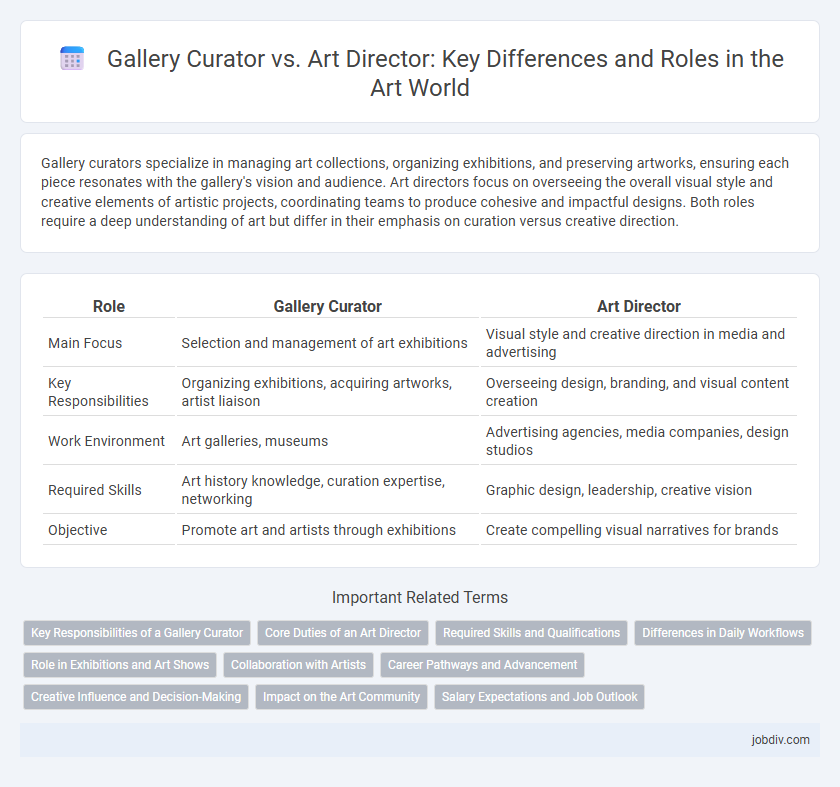Gallery curators specialize in managing art collections, organizing exhibitions, and preserving artworks, ensuring each piece resonates with the gallery's vision and audience. Art directors focus on overseeing the overall visual style and creative elements of artistic projects, coordinating teams to produce cohesive and impactful designs. Both roles require a deep understanding of art but differ in their emphasis on curation versus creative direction.
Table of Comparison
| Role | Gallery Curator | Art Director |
|---|---|---|
| Main Focus | Selection and management of art exhibitions | Visual style and creative direction in media and advertising |
| Key Responsibilities | Organizing exhibitions, acquiring artworks, artist liaison | Overseeing design, branding, and visual content creation |
| Work Environment | Art galleries, museums | Advertising agencies, media companies, design studios |
| Required Skills | Art history knowledge, curation expertise, networking | Graphic design, leadership, creative vision |
| Objective | Promote art and artists through exhibitions | Create compelling visual narratives for brands |
Key Responsibilities of a Gallery Curator
Gallery curators oversee the acquisition, management, and exhibition of artworks, ensuring collections align with the gallery's mission and audience interests. They research artists and artworks, organize exhibitions, and coordinate with collectors, artists, and sponsors to enhance cultural value and public engagement. Curators also handle cataloging, conservation, and educational programming to maintain the integrity and accessibility of the gallery's collection.
Core Duties of an Art Director
An Art Director oversees the visual style and creative direction of art projects, ensuring cohesive aesthetics across media such as advertising, publications, and digital platforms. Their core duties include conceptualizing design concepts, managing creative teams, and collaborating closely with clients to align visuals with brand identity. Unlike gallery curators who handle exhibition selection and art presentation, Art Directors focus on crafting compelling visual narratives that drive audience engagement and brand recognition.
Required Skills and Qualifications
Gallery curators require expertise in art history, strong organizational skills, and experience in exhibition planning to select and display artworks effectively. Art directors must possess creative vision, leadership abilities, and proficiency in design software to oversee the visual style and artistic elements in projects. Both roles demand excellent communication skills and a deep understanding of the art industry, but curators often emphasize academic credentials while art directors prioritize practical creative experience.
Differences in Daily Workflows
Gallery Curators primarily manage exhibition planning, artist selection, and artwork curation, ensuring cohesive and engaging displays that resonate with the gallery's vision. Art Directors focus on the creative direction of visual projects, overseeing design teams and conceptual development to maintain brand consistency across marketing materials and artistic productions. The daily workflow of curators involves extensive research, collaboration with artists, and logistical organization, whereas art directors prioritize visual strategy, project management, and creative leadership within advertising or media contexts.
Role in Exhibitions and Art Shows
Gallery curators manage the selection, organization, and interpretation of artworks for exhibitions, ensuring alignment with the gallery's mission and audience engagement. Art directors oversee the visual style and creative direction of art shows, coordinating with artists and designers to create cohesive and impactful presentations. Both roles are pivotal in exhibition success, but curators focus on content curation while art directors emphasize aesthetic execution.
Collaboration with Artists
Gallery curators collaborate closely with artists to select, organize, and present exhibitions that reflect the artists' vision while enhancing the gallery's narrative. Art directors work alongside artists to guide the creative process, ensuring each piece aligns with the overall aesthetic and conceptual framework of the project. Both roles emphasize communication, creative synergy, and respect for artistic intent to produce impactful and cohesive art experiences.
Career Pathways and Advancement
Gallery curators typically advance by gaining expertise in art history and collection management, often starting as assistants and progressing to senior curator roles or museum directorships. Art directors in the art world focus on visual strategy and creative project oversight, frequently moving from junior design positions to senior art director or creative director roles within galleries or agencies. Both career pathways require strong leadership skills and a deep understanding of art trends, but curators emphasize academic knowledge while art directors prioritize creative execution and brand vision.
Creative Influence and Decision-Making
Gallery curators shape artistic narratives by selecting and organizing exhibitions that reflect cultural relevance and historical context. Art directors drive the visual and thematic direction of projects, coordinating creative teams to realize a cohesive artistic vision. Both roles demand strategic decision-making, but curators emphasize cultural curation while art directors focus on conceptual execution and branding.
Impact on the Art Community
A gallery curator directly shapes the art community by selecting and exhibiting works that influence public perception and support emerging artists, fostering cultural dialogue within the local art scene. In contrast, an art director impacts the community more broadly by guiding the visual storytelling and brand identity of art institutions or media, enhancing accessibility and engagement through strategic artistic direction. Both roles are pivotal in nurturing artistic innovation and expanding the audience's appreciation of diverse art forms.
Salary Expectations and Job Outlook
Gallery curators typically earn between $50,000 and $80,000 annually, with salaries influenced by museum size and location, while art directors in galleries or museums command higher pay, averaging $75,000 to $120,000 due to their leadership roles in visual presentation. Job outlook for gallery curators shows steady growth at 5% over the next decade, driven by cultural institution expansions and digital curation demands; art directors are projected to grow 6%, supported by increasing multimedia art exhibitions and creative project management. Both positions require specialized education in art history or design, but art directors often benefit from experience in marketing or graphic design, enhancing their competitive salary potential.
Gallery Curator vs Art Director Infographic

 jobdiv.com
jobdiv.com